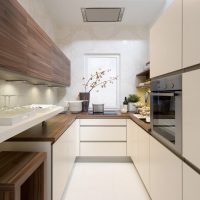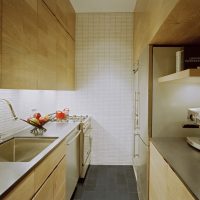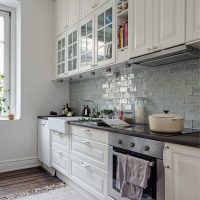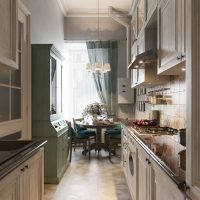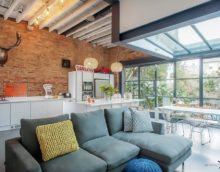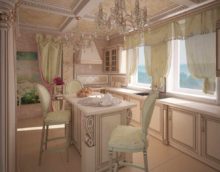Design features of a narrow kitchen
In small narrow rooms, excess space simply does not exist, so the design of a narrow small kitchen is aimed at saving every centimeter. Usually, not only the oven and cupboards take the place below, but also the freezer, dishwasher and washing machine, taking away already valuable meters. This article is intended to help effectively plan the design of a narrow kitchen, beat the walls to the maximum and usefully equip the space of the room.

A narrow room presents a number of design requirements, which can only be met by an integrated approach that takes into account every detail in the interior
Content
Narrow kitchen layout
It is necessary to effectively use the place under the ceiling, installing the hinged headset under its very edge. High hinged furniture will allow you to place more kitchen utensils.

An additional plus is the absence of dust gaps above the cabinets.

Instead of plugs - drawers on rails

Convenient carousel in the corner module
The width of the lower and upper cabinets should be the same, and the lateral borders of the upper should strictly coincide with the boundaries of the lower cabinet. Furniture can be either the same color or not (for example, the upper tier is white and the lower tier is with wood texture). The cut corners on the furniture look interesting, which becomes practical if the headset is next to the door. So the sharp corner will become harmless, and the passage into the room will help to make visually wider.
One-sided (linear) kitchen
Linear layout involves placing cabinets, countertops, kitchen appliances, as well as a refrigerator, stove and sink in one row. Not the most convenient design option, but for a very narrow kitchen it may be the only solution. Often the room does not allow to place equipment or furniture from the opposite wall, so that the wall remains bare (you can work on it later by adding bright colors and textures). The length of such a kitchen should not exceed 4.5-5 m, otherwise the cooking process will turn into winding kilometers.

Folding chairs are easy to clean when not needed

A special table does not take up much space in a compact position, and its retractable design allows you to double the table top if necessary
Tip. It is better to put the refrigerator either at the beginning or at the end of the kitchen, but not in the middle, so as not to tear the work space.

Optimal layout of a linear kitchen - sink between stove and fridge
It is most reasonable to place a sink in the center, just between the refrigerator and the stove. These kitchen elements should be placed next to each other, and not along the entire length of the narrow kitchen, especially if it is long enough. The compact arrangement of working areas will allow you not to waste in vain on movements.
Bilateral (parallel) kitchen
The layout of a two-sided narrow kitchen is perfect for long, not very narrow rooms. In this case, kitchen cabinets are located on both walls parallel to each other.Sometimes such a kitchen is called a galley: the name directly refers to the ship's galley - the kitchen room on the ship, where the set is located opposite each other as compactly as possible (to save limited space).

Instead of a windowsill, you can install a full countertop
This is a very convenient option for arranging a small room, which, unlike a linear narrow kitchen, allows you to use the wall opposite (placing there not only furniture, but also a sink). The passage should not be less than 120 cm, otherwise you risk turning the kitchen into a corridor. This place is enough for both work and for free passage of a person during the cooking process. But only the presence of a second cook can negatively affect comfort. And if the room is a walk-through, then people darting back and forth completely endanger themselves and the cook in the midst of cooking. But compliance with safety rules will nullify all the negative aspects.

Parallel kitchen with a window on a narrow wall

Between the rows of furniture there must be a passage with a width of at least 90 cm
A parallel kitchen can be walk-through and walk-through. In the latter case, in the absence of a window, it can be converted into a U-shaped. If there is a window, this place is best equipped for a dining area. If the layout of the apartment allows, you can demolish part of the wall and expand the room by combining with an adjacent room. Such an approach will help to modernize the interior and embody bold design decisions, which can be expressed in an unusual form with accented use of rich color.
Three-sided (U-shaped) kitchen
This layout is more suitable for square rooms. The installation of a U-shaped narrow kitchen is very similar to the previous version (galley). Usually the third wall has a window, and to save space, instead of a window sill, a countertop, curbstones or sink is installed. It is extremely undesirable to install a stove under the window: even if you prudently replace the fire hazard curtains with blinds, there will remain a problem with the hood, which is not very convenient to fix in this place. The dining area, most likely, will not fit, so it is better to have an additional dining room.

For a kitchen with a set of ledges it is better to make according to individual drawings
Corner (L-shaped) kitchen
The most successful way to maintain the proportions of the kitchen, without making it even narrower, as in the previous examples. The angular layout is very popular because it allows you to use two walls perpendicular to each other. The remaining space will allow you to place the dining table and chairs either near the window or near the free wall. It depends on where the corner of the L-shaped narrow kitchen will go. If near the window, then instead of the windowsill they put an additional working surface, under which shelves or drawers can be placed. Also, the corner may border the wall at the entrance to the room.

The planning decision depends on the geometry of the room, the presence of windows and doors
There is one detail that not everyone pays attention to when planning. It consists in the space of an angle, which, instead of functioning as a working area, is not used for its intended purpose. Over time, there appears a mountain of unnecessary things that do not contribute to the neat appearance of the room. The use of the kitchen accessories (kitchen carousel, retractable whatnot), the installation of a microwave oven, bread bins, etc. will help to maximize the use of the corner part.

Sink in the trapezoidal module takes up less space and allows maximum use of the angle
The cut or rounded corner shape in the kitchen furniture looks interesting. Trapezoidal furniture is especially useful for placing the sink directly in the corner, which makes it more convenient and comfortable to use.
Division of premises into zones
Before considering the design of a narrow kitchen, you need to start with the basics of planning, namely the division of the room into zones.In total, the kitchen should have at least two zones - a working and dining area, and if square meters allow, a recreation area will not be superfluous. We will consider in more detail about the arrangement of each below.

Narrow bar area dining area
Kitchen work area
When designing a work area, you need to remember the so-called triangle rule. Its meaning is to combine three important sections in the working space of the kitchen. These include a food storage area (refrigerator), a cooking area (stove, microwave, cutting table) and a washing area (sink, dishwasher). Their proper placement is necessary for maximum ergonomics, which will significantly save time and facilitate the cooking process.

Compact work area with dark worktop
Imagine a triangle drawn on the kitchen floor, on the tops of which there are three main elements - a stove, sink and refrigerator. You must select the correct distance, which should not be too large or small. To feel comfortable, just place the zone at a distance of 1.2 m to 2.7 m from each other. It is also considered ideal to observe the proportions of an equilateral triangle, but in a narrow kitchen this is not always possible to do.

Narrow kitchen layout options
You can use the following layout options:
- For a linear narrow kitchen, it is best to place work items in the order refrigerator-sink-stove, which intuitively tells the procedure (get food, wash and cook).
- For a parallel narrow kitchen, the location of the sink and stove is the opposite of the refrigerator and the desktop.
- For a corner and a three-sided narrow kitchen, the top of the triangle should be occupied by a sink, and it is better to place the stove and refrigerator at opposite corners, father-in-law on both sides of the sink.
Guided by the above recommendations, do not forget that a competent layout is designed to provide comfort. First of all, think about safety: running around the kitchen with boiling water at a large distance from the stove to the sink or table can damage family members at that time. So correctly plan the placement of work areas: put the stove near the desktop and sink, and the sink itself next to the refrigerator. Remember that the minimum distance between the refrigerator and the stove is 15-20 cm. To prevent the vain place from disappearing, you can place a compact cabinet between them, for example, for household chemicals.

The convenient layout of the kitchen will make the cooking process less tiring
For added convenience, do not store food throughout the kitchen; set aside a separate area for this. Let the cabinets and shelves for non-perishable provisions are located near the refrigerator. As an option, this will allow you to quickly arrange the purchased products in their places after going to the store.
Dining area in the kitchen
Placing a dining table in a narrow kitchenette is not always justified: it is seldom when it is conveniently placed, without disturbing anyone or blocking the passage. This problem is especially relevant for large families, for which it is advisable to set the table in a separate room (ideal if there is a dining room). But for small snacks or accommodation for a couple of three people, you can set the table on limited kitchen meters. And if the width of the kitchen and the layout allows, then completely organize a full-fledged soft corner, with which the dining area will turn into a cozy place to relax.

Cozy dining area with soft sofa

Transparent furniture contributes to a visual increase in space

Scandinavian-style dining table by the window in the kitchen
An ideal option would be a bar counter, a hinged narrow tabletop or transforming furniture. Such a solution is convenient, since the table does not take up much space.In a linear and parallel layout, the best place for it is an unoccupied wall with a window, where the tabletop replaces the windowsill. If you leave enough free space between the kitchen set and the perpendicular wall, you can successfully place a small sofa, equipped with a seating area. Even in a single-row kitchen, you can use the free walls with the benefit of hanging a removable worktop. And you do not need to put bulky chairs: enough small stools, which can always be hidden under a table.
Narrow Kitchen Design Principles
That's where you can enjoy the design process to the fullest, choosing the style and decorating the interior. But for small rooms there are special recommendations that will help visually expand the walls:
- give preference to the "simple" style (minimalism, Scandinavian, high-tech, loft, contemporary), because minimal detail will expand the space;
- Choose light shades that visually enlarge the walls and the room as a whole (e.g. walls and furniture in light beige);
- Do not neglect the decor of a bare wall in a linear layout, which will help to hide its length;
- do not neglect the “temperature” of the color: warm shades will make the room warmer and cold shades on the contrary;
- pay attention to mirrors - an ideal way to visually expand the room.

Narrow minimalist kitchen

A large mirror on the wall is a standard way to expand a small space
Feel free to connect your imagination and set bright accents - this is the main way to the unique design of a narrow kitchen. But do not overdo it with detail, because an excessive amount of small things conceals an already limited space.

The kitchen will seem more spacious if the usual cabinets are replaced with open shelves
Proper room lighting
Separately, I would like to note that the correct placement of bulbs in the kitchen plays an important role. Do not use one chandelier - it will not cope with the lighting of a narrow long room, but do not overdo it with bulbs, because a long row along the entire length can visually stretch the room, turning it into a tunnel or passage. It is better to accentuate kitchen areas by placing light bulbs above workplaces. And the use of wall-mounted floor lamps and warm-colored lamps near the dining area will emphasize it favorably and give comfort.

As a general lighting, it is better to use several lamps instead of one chandelier

In the working area, there must be a backlight under the wall cabinets.
Video: design and layout of a narrow kitchen











